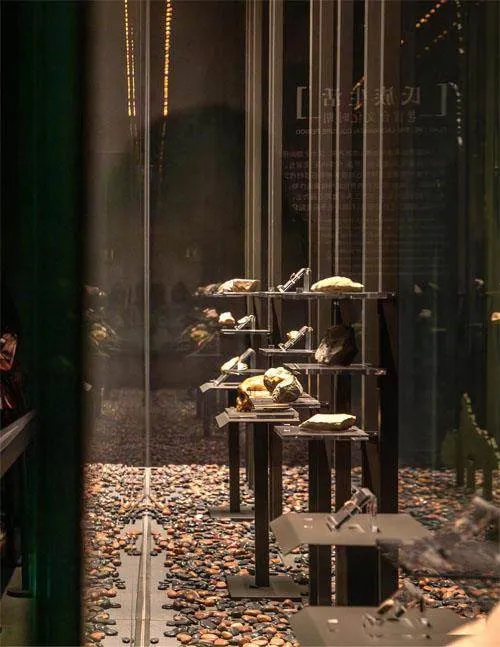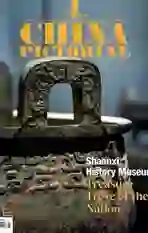Shaanxi History Museum:Pearl of the Ancient Capita
2024-08-21ZhangJingwen

The Shaanxi HistoryMuseum serves as anational beacon ofcivilization and avenue for national gatherings.It has earned the moniker“pearl of the ancient capital andtreasure trove of the nation.”It is energized by millennia ofcultural heritage and generatesresilience by tapping centuriesof historical shifts. Takingthe tide of China’s reformand opening up, it radiatesthe brilliance of the Chinesecivilization in the modern era.
Born in Spring
In 1978, China embarkedon a path of reform andopening up. Preparations forthe Shaanxi History Museumbegan that year. Constructionwas finally completed on June20, 1991, and China’s firstlarge modern museum sincethe launch of the reform andopening up opened to visitors.It bears witness to and plays arole in China’s reform journey.
Museums derive strengthfrom culture and the passageof time. With over 1.7 millionpieces (sets) of artifacts, theShaanxi History Museum’sextensive and valuablecollection in completesequences has defined itspivotal role in China’s culturaland museum sectors. Thefounding of the museum washailed as a milestone in thehistory of Chinese museums,spurring a surge in museumconstruction around thecountry and bridging thepersisting gaps with developedcountries.
Completion of the ShaanxiHistory Museum broughtthe glorious eras of Chinesecivilization spanning the Zhou(1046-256 B.C.), Qin (221-207B.C.), Han (202 B.C.-220 A.D.),and Tang (618-907) dynasties intothe modern age, reintroducingthe world to the ancient yetvibrant peak of Eastern culture.In the year when it firstopened, Jacques Chirac, whoserved two terms as presidentof France, visited the museumand called it “the world’s mostbeautiful museum,” noting itsmagnificent architecture, richexhibits, exquisite treasures,and historical significance.Leaders from around theglobe including former U.S.President Bill Clinton, formerU.S. Secretary of State HenryKissinger, Japanese EmperorAkihito, Spanish King FelipeVI, and former Greek PrimeMinister Costas Simitis havevisited the museum, whichshowcases China’s brightestcultural achievements on theworld stage.
Staying True to Original Aspirations
In Shaanxi’s archaeologicaland cultural sphere, a seriesof deeply ingrained principleshave prevailed: Archaeologicalexcavation is the foundation,technology-based preservationis the core, exhibitions areinstrumental, and servingsociety is the ultimate goal.Since its establishment, theShaanxi History Museum hasprioritized the development ofits exhibition capabilities as akey area of focus.
In 2008, national museumsand memorials in China beganopening to the public forfree, marking a significantdevelopment in the country’scultural and museum sectors.In March of that year, theShaanxi History Museumrevamped its primaryexhibition, “Shaanxi AncientCivilization,” and made it freelyaccessible to visitors. Its debutgenerated significant attentionin the cultural and museumsectors. The exhibition’sinnovative design, high-qualitycraftsmanship, and interactivedisplays integrated a millionyears of human history, overten thousand years of culturalhistory, and more than fivethousand years of civilizationin China.
Starting with the “ShaanxiAncient Civilization” exhibition,the Shaanxi History Museumhas engineered a series ofremarkable displays. Theseinclude themed exhibitionslike “Tang Dynasty Treasures:Exhibition of Cultural RelicsUnearthed at Hejia Village”that showcases the splendorof the Tang Dynasty’s ritualsystems, palace banquets,and social customs, and“Precious Tang DynastyMurals Exhibition,” whichoffers valuable insightsinto Tang Dynasty art andcultural exchange along theSilk Road. As research intothe museum’s collections hasdeepened, it has consistentlyearned recognition as one ofthe “Top Ten OutstandingNational Museums of China.”While continually innovatingexhibition formats, themuseum has also explorednew models for inter-museumcooperation.
Since the 18th NationalCongress of the CommunistParty of China (CPC) in 2012,China’s cultural and museumsectors have flourished thanksto a series of initiatives fromthe Party and the state. Duringhis visit to Shaanxi in 2015,President Xi Jinping, alsogeneral secretary of the CPCCentral Committee, highlightedthe importance of preservingand managing cultural relicsbecause they represent China’straditional culture. He alsostressed a need for enhancedresearch and innovativeutilization to enable history andcultural relics to speak.
Before life can be breathedinto artifacts, they must first leavestorages and find a place in anexhibition. Despite a collectionexceeding 1.7 million items,the Shaanxi History Museumdisplays only about 3,000 piecesto the public, leaving manynational treasures sealed instorages, which is regrettable.To inspire history and artifactsto speak, the museum followsthe latest achievements of theproject to trace the origins ofChinese civilization and othermajor archaeological projects asthey craft exhibitions featuringmore artifacts at the forefrontto contribute to the narrative ofcivilization.
The Qin and Han hall atthe Shaanxi History Museumopened to the public on May18 this year, marking a majormilestone and the onset of anew era in the developmentof the museum. Striving tobecome a world-class museumwith Chinese characteristics,the Shaanxi History Museumplans to collaborate with itsglobal counterparts to bridgehistory with the present,connect China and theworld, and uphold historicalpreservation while honoringcivilization.
